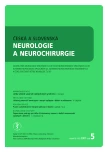„Inverse“ Syndroma Foster Kennedy in intracranial meningeoma: case report
Authors:
Z. Dúbravská 1; S. Řehák 2; V. Korda 1; H. Langrová 1; J. Studnička 1; J. Řehák 3; R. Malec 2
Authors‘ workplace:
Oční klinika LF UK a FN, Hradec Králové
1; Neurochirurgická klinika LF UK a FN Hradec Králové
2; Oční klinika LF UP a FN, Olomouc
3
Published in:
Cesk Slov Neurol N 2007; 70/103(5): 567-569
Category:
Case Report
Overview
Authors are presenting the case report of rare „inverse“ Syndroma Foster Kennedy, which was at the beginning, the reason of diagnostic dilema. Authors are discussing the presumable source of clinical symptoms based on results of graphical investigations caused by the intracranial meningeom. Unless the clinical symptoms will not be satisfactorily explained – central scotoma with optic atrophy and papilledema in the opposite eye by the ophthalmology origin, it is necessary to indicate the graphical brain examinations and exclude the intracranial tumour.
Key words:
Syndroma Foster Kennedy – Magnetic resonance imaging – meningeoma
Sources
1. Anderson M, Anderson I. Meningeomy a periferní úsek zrakové dráhy. Current Journals Oftalmologie 2000; 2: 1-5.
2. Jarus GD, Feldon SE. Clinical and computed tomographic findings in the Foster Kennedy syndrome. Am J Ophthalmol 1982; 93: 317–322.
3. Kennedy F. Retrobulbar neuritis as an exact diagnostic sign of certain tumors and abscesses in the fronta lobes. Am J med Sci 1911; 142: 355–368.
4. Lepore FE, Yarian DL. A mimic of the „exact diagnostic sign“ of Foster Kennedy. Ann Ophthalmol 1985; 17: 411–412.
5. Otradovec J. Klinická neurooftalmologie. 1. vyd. Praha: Grada Publishing 2003.
6. Otradovec J, Jirout J, Vymazal J, Lehovský M. „Inverzní“ syndrom Foster Kennedyho a pokus o výklad jeho patogeneze. Čs Oftal 1963; 4: 227–234.
7. Tonnis W, Krenkel W. Cerebral tumors without papilledema. Acta Neurochir (Wien): 1957; 5(2–5): 458–487.
8. Vladyková J. Několik poznámek k příznaku Foster Kennedyho. Čs Oftal 1968; 3: 183–191.
9. Watnick RL, Trobe JD. Bilateral optic nerve compression as a mechanism for the Foster Kennedy syndrome. Ophthalmology 1989; 96: 1793–1798.
10. Wowern F. The Foster Kennedy syndrome an evaluation of its diagnostic clue. Acta Ophthalmol Scan 1967; 43: 205–214.
Labels
Paediatric neurology Neurosurgery NeurologyArticle was published in
Czech and Slovak Neurology and Neurosurgery

2007 Issue 5
Most read in this issue
- Treatment of Epileptic Syndromes in Children
- Assesment of Optic Disc Edema
- Are some of the contraindications for lumbar punction outdated today? A Case Report
- Transforaminal lumbar interbody fusion (TLIF) and instruments. Prospective study with the minimum of 20-month follow-up
